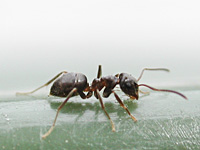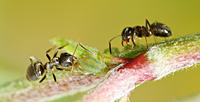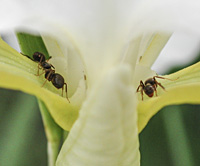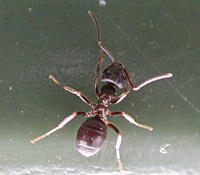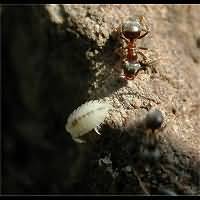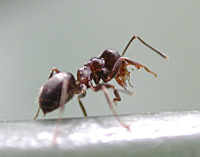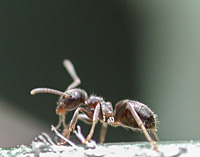[All pictures of garden wildlife on this page are thumbnails. Click on any thumbnail for a large format to be displayed.]

Black Garden Ant (Lasius niger)
| Taxonomy | ||||||
|---|---|---|---|---|---|---|
| Kingdom: | Phylum: | Class: | Order: | Family: | Genus: | Species: |
| Animalia | Arthropoda | Insecta | Hymenoptera | Formicidae | Lasius | L. niger |
The Black Garden Ant is the most common ant species in ruderal areas. It is fund to build a nest under garden tiles, stones or planks or whatever humans lay down. The Black Garden Ant even doesn't need a lot of space. In small rooms the colony simply remains smaller. And colonies of this species are highly variable in size: some hold some 2,000 animals, while big ones may be comprised of 15,000 individuals. The workers actually are dark brown but at a first glance they seem black. They reach a length of 3 to 5 mm, just like the males. Queens are bigger and some 7 to 9 mm. in length. The queen is has na impressive lonegivity of up to 22 years! Each nest has only one egg-laying queen.
The Black Garden Ant is extremely fond of sweet substances. It eats nectar from plants, but it is best known for milking aphids also known as plant lice (see 2nd photo here). Aphids excrete a very sweet liquid through the siphons on their body. The liquid is known as honey dew which the ants find irresistible. They have learned that when you tap an aphid on its back, it will produce even more honey dew. That tapping is called milking the aphids. In return the ants defend the aphids against many of their enemies, such as the larvae of lady beetles. The Black Garden Ant may even pick up an aphid and put it on an uninfested plant. But that is not all. When times are bad for the aphids, the ants may pick them up and transport them to their nest. And as conditions for the aphids are good again, the ants will put back the aphids on a suitable plant! This intricate behaviour is often referred to as farming the aphids.
A number of other animals live under the protection of the ants nest, such as some caterpillars of blues, a number of small beetles and the woodlouse in one of the pictures here: the Ant Woodlouse (Platyarthrus hoffmannseggi).
Humans are not very fond of the Black Garden Ant as they are nuissance in the gardens and around the house. They contribute to rapidly spreading of aphid infestation in the garden. And they even enter our homes when there is something they like. It has been observed that this ant is even capable of breaking through thin layers of cement. However should you find the much smaller Pharao Ant indoors you are in even more trouble. The Black Garden Ant has no stinger, but may bite you. The bite however is far less painful than the bite of the Red Wood Ant, or the sting of the Red Ant. The Black Garden Ant usually is more of a curious type, not an agressive type.
The Black Garden Ant is often simply referred to as the Garden Ant. Some people like to have a colony at home in a special housing called formicarium. This is a very common species all over Europe, especially when there is human activity.
The Black Garden Ant rather lives high up in trees and bushes and is rarely seen. Yet this is a common species all over the British Isles. It sometimes sucks on leaves and fruit, but it clearly prefers to hunt for its own prey. The cold doesn't really stop this species and in winter is is one of the very few enemies of winter moths, such as the Mottled Umber Moth. The Black Garden Ant is common in forests, parks and larger gardens and also frequently spotted in shady avenues.

© Copyright 1998-2024 gardensafari.net (Hania Berdys)

 English / engels
English / engels  Dutch / nederlands
Dutch / nederlands